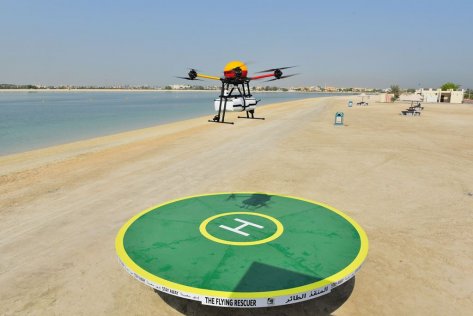Developed locally, the Flying Rescuer can transport up to four rings of lifebuoys, support up to eight drowning people at the same time
 Dubai Municipality today unveiled a new drone that can simultaneously rescue a group of people from drowning.
Dubai Municipality today unveiled a new drone that can simultaneously rescue a group of people from drowning.
The Unmanned Aerial Vehicle (UAV), developed in-house, has the capacity to save a group of eight people simultaneously. In what is being termed as the first such drone in the world, in terms of functionality, it can even carry rescue rafts that automatically inflates upon touching the water.
The “Flying Rescuer,” as it has been named will be the latest tool to be deployed by the Coastal Rescue and Safety System run by the Municipality, as it plans to eliminate incidents of drowning across the emirate’s beaches.
The unique design of the drone, developed locally, enables it to respond to group or individual drowning cases says Eng. Alia Al Harmoudi, Director of Environment Department.
“The drone can transport up to four rings of lifebuoys to the drowning incident area which can support up to eight drowning people at the same time. It can also be used with a rescue raft that automatically inflates when it touches the water instead of buoys to save several people at the same time. The “Flying Rescuer” gives the initial response to drowning so that the human rescuers have access to the situation, which makes the rescue operations on holidays and weekends easier,” says Al Harmoudi.
The drone consists of a double fan mounted on four folding arms known as Octa-X8 capable of carrying a load of eight kilograms. It can be remote controlled manually or by determining a specific path for the device and launching it on auto mode to automatically follow its path. It is also possible to remotely control the launch of rescue buoys or rafts reaching the drowning site. The drone is also equipped with two cameras, one for high precision navigation for live video transmission up to one kilometer from the control point and the other to facilitate the launch of rescue pipes and buoys to the drowning area.
 The UAV is also equipped with an integrated system for addressing the public. The system enables remote voice guidance to be delivered from the control point of the device, which is very useful in cases of collective drowning or in the case of sweeping currents. It has a battery life of up to 30 minutes and can operate at high temperatures.
The UAV is also equipped with an integrated system for addressing the public. The system enables remote voice guidance to be delivered from the control point of the device, which is very useful in cases of collective drowning or in the case of sweeping currents. It has a battery life of up to 30 minutes and can operate at high temperatures.
According to Khalid Sharif Al Awadhi, Chief Executive Officer of Environment, Health and Safety Sector at Dubai Municipality, the “Flying Rescuer” is the first of its kind in the world. “UAVs that are currently being used around the world are designed only for individual rescue operations,” he says.
In what is being termed as the first such rescue mission, in January this year, lifeguards managed to rescue two boys who were drowning at a beach in New South Wales, Australia.
Companies are also working on drone software that can use artificial intelligence to identify swimmers who could be on the verge of drowning.





